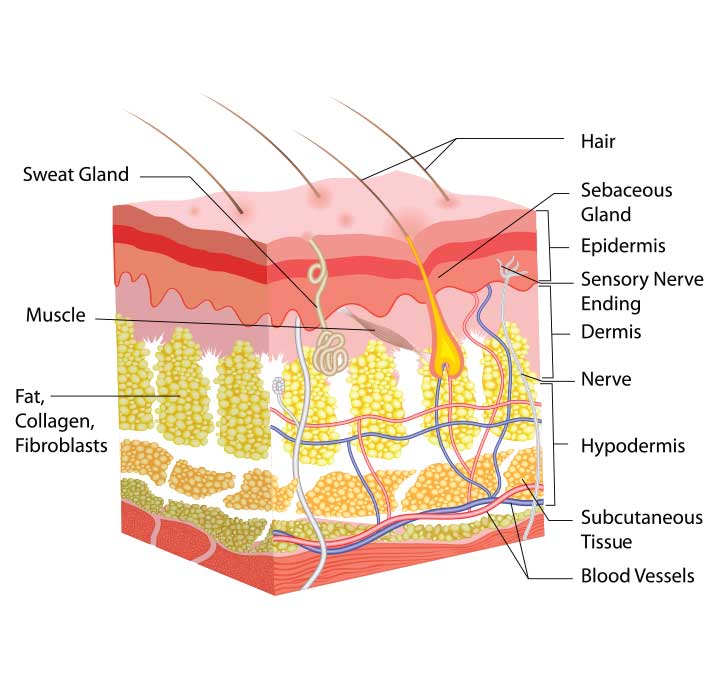Directly beneath the epidermis is the dermis, and it functions primarily to support the epidermis. As well, the dermis supplies the epidermis with things that are important, such as, oh, blood! The dermis does vary in thickness depending upon the area of the body just like the epidermis. Overall, there are fewer cells within the dermis, this layer is composed of many more structural components such as collagen.
Technically, there are layers, however this is less of structured tissue than the epidermis:
1. Papillary Layer- This layer is thinner and more superficial. It has all 3 tissue types, but is loosely packed. This layer also contains capillaries, which are small blood vessels and they are primarily supplying the epidermis and dermis.
2. Reticular Layer- A deeper layer, this is more densely packed, the blood vessels here are larger, and the tissues are just larger in general.
Both of these layers are made up of several tissue types and other components:
1. Collagen- Think of collagen as a rigid structural component of the dermis, really helping to support the skin. The dermis is about 85% Collagen, and these long proteins will link together to provide even more support. There are several types of collagen, we won’t get into that here.
2. Elastic Tissue- Less than 1% of the dermis, but these fibers really do what it sounds like they do- they help the dermis “snap” back into shape.
3. Reticular Fibers
4. Cells- There are two main types of cells:
a. Fibroblast- These cells create collagen and elastin, and they can be stimulated to do so!
b. Macrophage- These are the scavengers of the skin, they are part of the immune system.
5. Ground Substance- I tend to think of all the cells and tissues (the collagen, elastic and reticular fibers) as sitting in a jello-like substance, this is the ground substance. The things that make up the ground substance are made by the fibroblasts and consists of mucopolysaccharides (primarily hyaluronic acid), chondroitin sulfates, and glycoprotein. Notice that some of those things probably sound familiar, especially hyaluronic acid. These are bigger proteins, and they are way too big to be moving between layers of the skin. This means that you can’t put them on the surface of the skin and expect them to get down to this layer, where they’ll do some good! But, when they’re here in the dermis, they help the skin hold its structure.
Special Structures found within the dermis:
1. Oil (sebaceous) Glands
2. Scent (apocrine) Glands
3. Eccrine (sweat) Glands
4. Hair- We will discuss hair much more in detail later in the series
5. Nerves, Touch and Pressure sensors
Learn more about the Epidermis and the Subcutaneous Tissue.


 I’m a doctor, a mommy and a bit of a beauty addict. If you let me, I can take 2 hours to get ready in the morning. Really. I'm on a quest for faster beauty that works!
I’m a doctor, a mommy and a bit of a beauty addict. If you let me, I can take 2 hours to get ready in the morning. Really. I'm on a quest for faster beauty that works!
Hi Dr. Christine. There is a product by U Beauty called Resurfacing Compound. May you please let me know if this is ok to use during pregnancy? Here is a list of the ingredients:
Aqua (Water), Aloe Barbadensis Leaf Juice Powder, Sodium Ascorbyl Phosphate, Dimethyl Sulfone, Citric Acid, Polysorbate 20, Glycerin, Hamamelis Virginiana (Witch Hazel) Leaf Extract, Sodium Hyaluronate, Glycolic Acid, Superoxide Dismutase, Lactobionic Acid, Hydrolyzed Hyaluronic Acid, Glutathione, Acacia Decurrens/jojoba/sunflower Seed Wax/polyglyceryl-3 Esters, Mandelic Acid, Linoleic Acid, Retinyl Palmitate, Helianthus Annuus (Sunflower) Seed Oil, Oleic Acid, Palmitic Acid, Stearic Acid, Tocopherol, Linolenic Acid, Xanthan Gum, Pentylene Glycol, Butylene Glycol, Methyldihydrojasmonate, Hydroxyphenyl Propamidobenzoic Acid, Caprylyl Glycol, N-prolyl Palmitoyl Tripeptide-56 Acetate, Benzyl Alcohol, Dehydroacetic Acid
This has a retinoid. Avoid in pregnancy and in nursing if you’re conservative